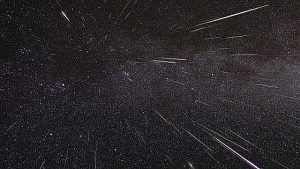
If up late at night or early in the morn before dawn this weekend, check the sky for a “falling star.” It will be a Lyrid meteor that would have emanated from near the bright Vega star in the Lyra the Harp constellation.
You don’t really need to try to find the meteor’s radiant point because if lucky enough to see a Lyrid meteor it will appear brighter and longer away from where it seems to start.
The Lyrid meteor shower, considered among the oldest to have been recorded (about 687 B.C.), annually appears about mid to the end of April and peaks around April 21-22.
This year, 2018 there is a quarter moon Saturday night that sets early so the sky should be dark enough after midnight and before dawn Sunday to watch the meteors at their peak. However, you should find a spot away from city and highway bright lights
Meteor shower watchers know they that what they see are debris from a comet. In this case it is the C/1861 G1 Thatcher. But you can forget that info and just enjoy seeing a meteor streak across the sky.
Jodie Jacobs
(For more info check Earth/Sky, Space.com/ and NASA.)
